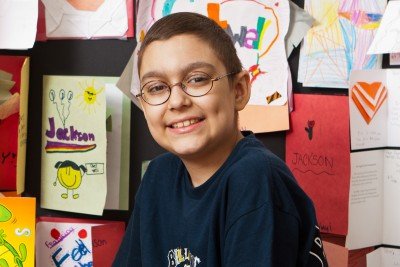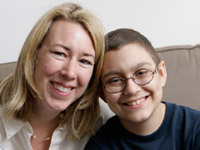Jackson’s Story
Jackson, age ten, had just returned from sleepaway camp when his mother discovered a small, grape-size bump on the top of his head. Other symptoms that began later – a persistent fever, nausea, and fatigue – seemed like those of an ordinary virus. However, Jackson was later diagnosed with acute lymphoblastic leukemia, the most common form of childhood leukemia. Instead of starting fifth grade, he began treatment at Memorial Sloan Kettering.

In August 2005, Jackson Halebian, a smart, watchful ten-year-old, had just returned from a summer sleep-away camp in upstate New York. In welcoming her son home, Jackson’s mom, Lisa, went to tousle Jackson’s hair, only to discover a small, grape-sized bump on top of his head. Thinking it no more than an after-effect of the usual rough-housing that takes place at camp, the Halebians went forward with their end-of-summer vacation. On the trip, Jackson developed a persistent fever and complained of nausea and a general feeling of fatigue. His mother felt that these symptoms, combined with the bump on his head, were enough to warrant a visit by her son to a nearby medical clinic. There, Jackson was diagnosed with an ordinary virus.
Returning from vacation in North Carolina to the Halebian’s home in Manhattan, Lisa took Jackson to his pediatrician, Dr. Karen Lancry, who ran a number of blood tests. The results were serious enough to prompt an immediate referral to a hematologist. The hematologist, worried about Jackson’s fever, had him admitted to the hospital and the following day, September 7th, ordered a bone marrow biopsy. When the biopsy results came back, the news was crushing — Jackson didn’t have a virus, he had acute lymphoblastic leukemia (ALL), to be exact. (ALL, the most common form of childhood leukemia, occurs when immature white blood cells, called lymphoid cells, mutate and multiply in an uncontrolled way.)
“September 7th also happened to be our daughter’s 16th birthday,” Lisa Halebian recalls. “Needless to say, it wasn’t a day of celebration.”
Learning about the “Bad” Cells
After it was explained to him that leukemia is a form of cancer, Jackson’s first question was whether or not he would lose his hair. He was told he probably would as a result of the chemotherapy he would receive. The information was almost too much for him to process. “I still remember the part when they told me that leukemia was like bad cells that are naughty and don’t listen, like teenagers,” Jackson says, able now, in hindsight, to grin at the memory.

Lisa and Jackson
Although Jackson was being treated at another New York hospital, Jackson’s pediatrician, Dr. Lancry, recommended that he be transferred to Memorial Sloan Kettering. Dr. Lancry, who had rotated through Sloan Kettering during her residency, said that, for cancer, it was the best place in the world, and that Peter G. Steinherz, the Director of Leukemia and Lymphoma Studies there, was an established authority.
When asked to recall this time, Jackson’s recollection is succinct. “I was scared,” he says with unabashed honesty. The timing couldn’t have been worse. Jackson was scheduled to start the first day of fifth grade later that same week. When he asked Dr. Steinherz if he was going to have to miss the first day of school, Dr. Steinherz’s response came as a shock. “You’re going to miss the first day of school,” Dr. Steinherz said, “and you’re probably going to miss a lot more.”
During an initial phase of disbelief, fear, and confusion, Lisa began to keep a notebook of questions for Dr. Steinherz. Whenever Jackson asked her about something she couldn’t answer, the question went into the notebook for her next meeting with Dr. Steinherz. As time went on, this proved to be a very helpful coping mechanism for the entire family.
“The first few days in the hospital are very intimidating,” Lisa says. “You’re seeing kids with different kinds of cancer in different stages of treatment, some in wheelchairs, some bald, and it all just sort of clobbers you.” What helped during this transition, she says, was the practice Memorial Sloan Kettering has of assigning specific nurses to specific patients. “Seeing the same familiar faces really helps to ease some of the strain.”
Treatment Begins
Chemotherapy for ALL is given in several stages. The first stage is called induction therapy, the goal of which is to put the disease in remission — killing close to 99 percent of the unhealthy cells, while allowing healthy blood-cell production to resume. Jackson started almost immediately on his induction course of therapy, which included pills, infusions, and injections. Jackson described one of his leukemia treatments to his friends as a Hawaiian Punch-like liquid that gets injected into his bloodstream. As is commonly the case, his sense of smell, and its direct link to nausea, was made more acute by the chemotherapy drugs. “I could smell pizza from down the hallway,” he remembers, “and the lettuce in my roommate’s salad.”
By the time the induction therapy was completed, in late September, Jackson was feeling energetic enough to go home. Lisa, remembering being initially overwhelmed by the number of medications they returned with, says, “I had a stack of medicines and a notebook of what I was supposed to give when. And I was a little freaked out by it all.”
Meanwhile, Jackson continued with his chemotherapy regimen but on an outpatient basis, which made things more bearable. In order to prepare for his impending hair loss from the chemotherapy (which didn’t happen until several weeks after treatment started) Jackson had his hair cut by his personal barber, Roger, at home. Even amidst treatment, Jackson kept up with his schoolwork, which he did at home under the guidance of a Department of Education home tutor. A classmate from Jackson’s school lived a few blocks away and was able to deliver school assignments and notes to Jackson for use in his tutoring sessions.
The hardest part of this second phase in Jackson’s treatment (known as the consolidation phase) was the handful of infections he developed — one during his tenth birthday party — each of which required intravenous antibiotics and several days of hospitalization. The consolidation phase also involved chemotherapy injected directly into Jackson’s spinal fluid. (For some patients, a pool of leukemia cells may be “hiding” in the central nervous system, where chemotherapy cannot reach them. After the initial chemotherapy session, these hidden leukemia cells are targeted using chemotherapy injected into the fluid around the spinal column.) “They did five of these weekly spinal taps in a row,” Lisa explains. “That was quite traumatic for him.”
Jackson’s Lifeline: His Friends
What helped Jackson through this difficult period were his friends from school and church, who would call him often and send him get-well cards on his birthday as well as on every major holiday. “I liked talking to my friends,” Jackson explains. “My mom and dad got me my own cell phone for my birthday, so that I could call my friends whenever I wanted to, which was a big help.” Cousins and other relatives also kept in touch and helped to lift Jackson’s spirits.
For Lisa, the most effective coping mechanism was staying in touch with family and friends through phone calls and especially e-mails. “Sometimes I’d be just too tired to talk, so e-mails were perfect.”
In January of 2006, Jackson, while still too immune-compromised to return to school, started attending the Huntington Learning Center, which allowed him to get out of the house. Combining the four hours-a week at Huntington, the six hours-a week of home tutoring, and help from Memorial Sloan Kettering’s own staff teacher, Jackson was able to keep pace with his fellow students’ academic progress. “It was important to him not to fall behind his classmates,” Lisa explains. “I didn’t want to be the not smart one,” Jackson adds.
Around this time, to keep all his classmates informed of his progress and to thank them for all their cards and calls, Jackson wrote them a letter, which began, in an example of Jackson’s unflagging sly humor, “Hi. It’s very boring not going to school. All I can do is rot in front of the TV. Just kidding!!! I miss you so much, and I like all the presents you got me. Also, I like all the cards. My parents’ friend got me a Nintendo DS. How cool is that!”
Back to School and Advice for Others Recently Diagnosed
On April 3rd, Jackson returned to school. “I was so glad to be back,” Jackson says, investing the “so” with such emphasis that there is little doubt to his sincerity. For the next three years, he will remain on what is known as maintenance therapy, in which a combination of chemotherapy medicines are given to ensure that any cells that may have been dormant initially are targeted and destroyed.
When asked for any advice he may have for other kids recently diagnosed with cancer and their families, Jackson takes a moment to think, then offers, “I’d say just listen to what your doctor says. If you do what he tells you to do, then it’ll be OK.” Lisa responds to the same question by saying, “I think you have to focus on the positives. For me, I thought of all the amazing friends we have. I thought how fortunate we are to live in the time of modern medicine, where they actually have treatments and cures. And I think how we are lucky enough to live down the block from one of the most renowned cancer centers in the world.”
